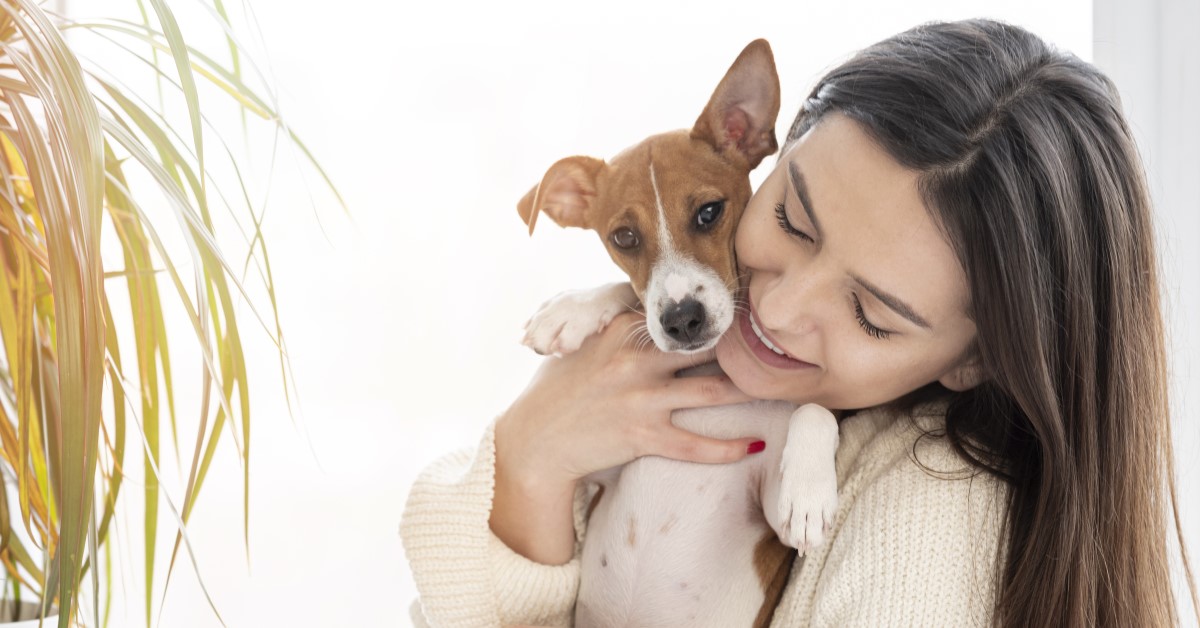Benefits of Cuddling Your Pet: Oxytocin, Health, and Well-Being
Cuddling your pet can hold surprising health, wellness, and happiness benefits for both of you.

Nothing enhances a lazy weekend in bed or quiet Friday evening in front of the TV more than some cuddle time -- and not necessarily with your fellow humans. Household pets such as dogs and cats often enjoy cuddling up to their pet parents, and vice versa. But even an experienced pet owner may not realize that these casual displays of affection can offer far-reaching benefits for both parties.
The Link Between Pet Cuddling, Physical Health, and Emotional Wellness
The simple act of cuddling your pet can support optimal health for both of you. Research indicates that it triggers the release of oxytocin, a hormone associated with love and comfort. This extra dose of oxytocin has a calming effect on pets and people alike. This serenity can result in lower levels of the stress hormone cortisol -- which in turn can help to reign in anxiety and high blood pressure while supporting a strong immune system.
Both dogs and cats cuddle as an instinctive behavior. For puppies and kittens, cuddling with their mother and siblings provides essential warmth and reassurance - as you already know if you've ever seen a litter of newborns huddled close together against their mother. Your pet can carry this behavior into adulthood by cuddling against you as its adoptive parent.
Because oxytocin inspires feelings of safety and trust as well as happiness, cat or dog cuddles can serve as a valuable aid to socialization. Pets who grow accustomed to a human touch from a young age learn not to feel fearful or upset around people. Early socialization can make your pet feel more comfortable, and behave in a friendlier manner, whenever you take it into public environments or welcome visitors to your home. You may even find that your pet actively seeks cuddles from total strangers!
Pet cuddling can produce some surprisingly specific health benefits for humans. For example, studies have suggested that pet owners who enjoy cat cuddling may experience a lower incidence of non-Hodgkin's lymphoma due to the immune system benefits this behavior offers. Dog cuddling with a therapy pet can also soothe post-traumatic stress disorder (PTSD). Stress relief from cuddling may even lower your risk for cardiovascular diseases, thanks to its effects on blood pressure.
Pet Cuddling Dos and Don'ts
Despite the many clear benefits of cat or dog cuddling, you need to understand there are better and worse ways to go about it. Some pets enjoy cuddling more than others; for instance, cat breeds such as Siamese, Persian, Maine Coon, and Ragdoll cats typically welcome affection, while others may prove more standoffish. Even pets eager for cuddles may react poorly to the wrong kind of affectionate display.
Many people assume that dogs always love being patted on the head. In fact, most dogs actually dislike this form of contact. Your dog may close its eyes, turn its head to the side, tuck it tail, lick its nose, or even yawn to show its displeasure -- responses that you could easily misinterpret as contentment. By contrast, dogs generally love pats and scratches on the chin, belly, and bottom, so concentrate on those areas instead.
Cats tend to have more of an independent streak than their canine counterparts, and they don't necessarily feel like being cuddled all the time. Watch out for warning signs such as flattened ears, hissing, yowling, growling, teeth showing, tail twitching, and swatting at the offending hand with a paw. These signs all indicate that you should put off those cat cuddles until your feline pal feels more open to them.
Pet owners should also recognize a crucial difference between cuddling (which can include various kinds of gentle pats, scratches, and caresses) and hugging. While humans may enjoy a nice, tight hug, dogs and cats often feel discomfort or alarm at feeling squeezed, threatened, or trapped by a pair of hands. A well-intentioned hug could even provoke an aggressive reaction from your normally friendly pet. When you hold your cat or dog, do so loosely, with as little pressure on its body as possible, or simply let your pet flop onto your lap or into your arms of its own volition.
Just as you can spot the signs that your pet doesn't like some kinds of cuddling, you'll also know when it does. A dog's eyelids may droop as its body visibly relaxes up against yours. A cat may purr, rub or bump its head against you, or leap right into your lap for cuddles.
Catch Health Problems Early by Cuddling Your Pet
Cuddling offers one more significant health benefit for your furry friend -- the chance for you to notice any potential health problems. For instance, if you see or feel a mysterious lesion when you scratch your pet's belly or chin, you'll know to schedule a wellness exam with your trusted veterinarian, if only to make sure everything's okay. Any unusual or hostile responses to normal cuddling practices might also merit a conversation with your vet. In the meantime, follow the tips above to enjoy many years of mutual affection -- and its associated benefits -- with your beloved pet.
Ready to start saving money on pet wellness care?
Then take a look at Mint Wellness, the pet wellness plan that provides fast reimbursement on routine pet care. Save on vaccinations, wellness exams, preventatives, dental, and more!
Learn More


